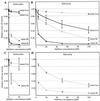An isoleucine/leucine residue in the carboxyltransferase domain of acetyl-CoA carboxylase is critical for interaction with aryloxyphenoxypropionate and cyclohexanedione inhibitors
- PMID: 11381131
- PMCID: PMC34402
- DOI: 10.1073/pnas.121172798
An isoleucine/leucine residue in the carboxyltransferase domain of acetyl-CoA carboxylase is critical for interaction with aryloxyphenoxypropionate and cyclohexanedione inhibitors
Abstract
cDNA fragments encoding the carboxyltransferase domain of the multidomain plastid acetyl-CoA carboxylase (ACCase) from herbicide-resistant maize and from herbicide-sensitive and herbicide-resistant Lolium rigidum were cloned and sequenced. A Leu residue was found in ACCases from herbicide-resistant plants at a position occupied by Ile in all ACCases from sensitive grasses studied so far. Leu is present at the equivalent position in herbicide-resistant ACCases from other eukaryotes. Chimeric ACCases containing a 1000-aa fragment of two ACCase isozymes found in a herbicide-resistant maize were expressed in a yeast ACC1 null mutant to test herbicide sensitivity of the enzyme in vivo and in vitro. One of the enzymes was resistant/tolerant, and one was sensitive to haloxyfop and sethoxydim, rendering the gene-replacement yeast strains resistant and sensitive to these compounds, respectively. The sensitive enzyme has an Ile residue, and the resistant one has a Leu residue at the putative herbicide-binding site. Additionally, a single Ile to Leu replacement at an equivalent position changes the wheat plastid ACCase from sensitive to resistant. The effect of the opposite substitution, Leu to Ile, makes Toxoplasma gondii apicoplast ACCase resistant to haloxyfop and clodinafop. In this case, inhibition of the carboxyltransferase activity of ACCase (second half-reaction) of a large fragment of the Toxoplasma enzyme expressed in Escherichia coli was tested. The critical amino acid residue is located close to a highly conserved motif of the carboxyltransferase domain, which is probably a part of the enzyme active site, providing the basis for the activity of fop and dim herbicides.
Figures



References
-
- Ohlrogge J B, Jaworski J G. Annu Rev Plant Physiol Mol Biol. 1997;48:109–136. - PubMed
-
- Page R A, Okada S, Harwood J L. Biochem Biophys Acta. 1994;1210:369–372. - PubMed
-
- Devine M D. Pestic Sci. 1997;51:259–264.
-
- Herbert D, Walker K A, Price L J, Cole D J, Pallett K E, Ridley S M, Harwood J L. Pestic Sci. 1997;50:67–71.
-
- Incledon B J, Hall J C. Pestic Biochem Physiol. 1997;57:255–271.
Publication types
MeSH terms
Substances
Associated data
- Actions
- Actions
- Actions
- Actions
- Actions
- Actions
- Actions
LinkOut - more resources
Full Text Sources
Other Literature Sources
Miscellaneous

